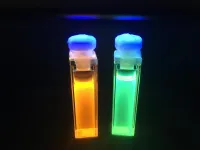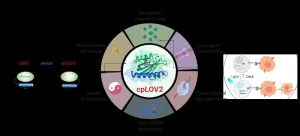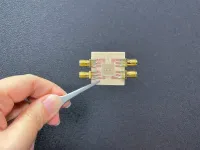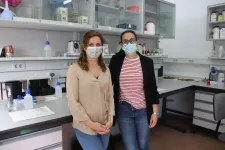Electric cars: Special dyes could prevent unnecessary motor replacements
2021-05-18
(Press-News.org) One day in the near future dyes in electric motors might indicate when cable insulation is becoming brittle and the motor needs replacing. Scientists at Martin Luther University Halle-Wittenberg (MLU), together with ELANTAS, a division of the specialty chemicals group ALTANA, have developed a new process that enables the dyes to be directly integrated into the insulation. By changing colour, they reveal how much the insulating resin layer around the copper wires in the motor has degraded. The results were published in the journal "Advanced Materials".
Modern combustion engines have long had detectors that recognise, for example, when an oil change is needed, saving unnecessary inspections. Electric motors also show signs of wear. Inside, they are usually made up of tightly wound copper wires - and these in turn are coated with an insulating resin. "This insulation changes over time. It becomes brittle as it degrades dues to heat and chemical processes," explains Professor Wolfgang Binder from the Institute of Chemistry at MLU. However, it is not possible to tell from the outside whether the insulation around the wires inside is still intact or whether the entire motor needs to be replaced.
The scientists from MLU were tasked with finding a solution to this problem on behalf of the ELANTAS division of ALTANA, which produces special resin systems for such insulation. "Until now, developers have focused on the degree to which material degrades under specific conditions," explains Alexander Funtan, a chemist at MLU. Recommendations were then made as to how long it would take before a replacement would be necessary. However, the actual wear depends on the conditions under which it is used, most particularly temperature. Funtan therefore developed a test rig which he used to analyse four different resin systems over several months to determine which degradation products form at different temperatures.
He discovered that the four resin systems consistently released a specific alcohol under the different temperature conditions. "We then worked closely with the researchers and developers at ELANTAS to find a sensor molecule for this alcohol," he says. In other words, a substance that is easily detectable and whose properties change when the alcohol binds to it. The sensor molecule must also withstand high temperatures and normal production processes. Another requirement was that it did not change the insulation's electrochemical properties. The choice fell on a dye that normally glows reddish orange under UV light; but when alcohol binds to it, the colour spectrum shifts to a light green.
The different colour spectra could then be analysed using special devices that could be installed directly in the engine. "This way, you can see if a replacement is necessary without having to open up the engine," says Binder. This will hopefully avoid unnecessary motor replacements in the future. The new insulation could be used in the motors of electric vehicles as well as in machines and other equipment. "These results reveal what can be achieved by combining basic university research with commercial application know-how," says Dr Simon Rost, head of research & development at ELANTAS in Hamburg. "In the future, this will enable us to provide added value to our customers and further contribute to sustainable development."
ELANTAS filed a patent for the new process at the beginning of the year. The research was financed by the specialty chemicals group ALTANA and also funded by the EU's BAT4EVER project as part of the "Horizon 2020" programme.
INFORMATION:
About the study: Funtan, A. et al. Self-Diagnostic Polymers - Inline Detection of Thermal Degradation of Unsaturated Poly(ester imide)s. Advanced Materials (2021). doi: 10.1002/adma.202100068
[Attachments] See images for this press release:

ELSE PRESS RELEASES FROM THIS DATE:
2021-05-18
Combining natural salt marsh habitats with conventional dikes may provide a more sustainable and cost-effective alternative for fully engineered flood protection. Researchers of the University of Groningen (UG) and the Royal Netherlands Institute for Sea Research (NIOZ) studied how salt marsh nature management can be optimized for coastal defence purposes. They found that grazing by both cattle and small herbivores such as geese and hare and artificial mowing can reduce salt marsh erosion, therefore contributing to nature-based coastal defence.
People around the world live in coastal areas that are ...
2021-05-18
Recently, Prof. WANG Junfeng from the High Magnetic Field Laboratory of the Hefei Institutes of Physical Science (HFIPS), together with international scholars, developed a novel circular permutated light-oxygen-voltage 2 (LOV2) to expand the repertoire of genetically encoded photoswitches, which will accelerate the design of novel optogenetic devices. The result was published in Nature Chemical Biology.
LOV2 domain is a blue light-sensitive photoswitch. In a typical LOV2-based optogenetic device, an effector domain is fused after the C-terminal Jα helix of LOV2, intending to cage the effector via steric hindrance in the dark. On photostimulation, light-triggered unfolding of the Jα helix exposes the effector domain to restore its function. Crafting a LOV2-based ...
2021-05-18
With the rise of the digital age, the amount of WiFi sources to transmit information wirelessly between devices has grown exponentially. This results in the widespread use of the 2.4GHz radio frequency that WiFi uses, with excess signals available to be tapped for alternative uses.
To harness this under-utilised source of energy, a research team from the National University of Singapore (NUS) and Japan's Tohoku University (TU) has developed a technology that uses tiny smart devices known as spin-torque oscillators (STOs) to harvest and convert wireless radio frequencies into energy ...
2021-05-18
A new study may have uncovered why wall lizards have become the most successful reptile in the Mediterranean region. The results reveal how drastic changes in sea levels and climate 6 million years ago affected species formation in the area. The researchers believe they can now explain why the lizards became so diverse and widespread, something that has puzzled biologists since the 19th century. The study is published in Nature Communications.
The evolution of wall lizards offers clues on how major events in the Mediterranean climate and geology millions of years ago affected how species formed or became extinct, and also paved the way for biodiversity.
Wall lizards date back around 20 million years. However, ...
2021-05-18
A University of Surrey project has revealed innovative methods that could dramatically improve the performance of future electrical vehicles (e-vehicles).
As part of the European Union's STEVE* project, Surrey has developed several pioneering approaches to torque vectoring in electric vehicles.
In e-vehicles with multiple motors, it is possible to deliver different amounts of drive power to each wheel. This benefits the vehicles' power consumption, safety and driveability. The process of calculating and optimising the precise amount of power needed while the vehicle ...
2021-05-18
To support growing human and animal life, freshwater sources must continuously supply water. Freshwater from lakes, rivers, and underground is mainly recharged by rainfall. Ground reservoirs can store rainwater over time, depending on that location's storage capability. However, estimating freshwater storage capability (FSC) is still a challenge due to few observation opportunities and methods to measure and quantify FSC.
Prof. Xing Yuan and his Ph.D. student Enda Zhu, from the Institute of Atmospheric Physics at the Chinese Academy of Sciences, developed and applied a new metric that characterizes the "inertia" of water after rainfall. This method allows better ...
2021-05-18
A research group at the University of Córdoba studied the molecular properties of the holm oak (Quercus ilex) in search of trees that are more resistant to drought and root rot.
One of the biggest problems affecting holm oaks is drought. The holm oak (Quercus ilex) boasts a high natural adaptability and resistance to inclement weather conditions in dry environments with high temperatures. However, drought is one of the main causes of mortality in holm oak plantations, with "drought stress" also an important factor contributing to root rot.
This is a multifactorial syndrome that causes the decay and death of holm oaks, consisting of a combination ...
2021-05-18
Scientists have developed a mathematical model that predicts how the number and effects of bacterial mutations leading to drug resistance will influence the success of antibiotic treatments.
Their model, described today in the journal eLife, provides new insights on the emergence of drug resistance in clinical settings and hints at how to design novel treatment strategies that help avoid this resistance occurring.
Antibiotic resistance is a significant public health challenge, caused by changes in bacterial cells that allow them to survive drugs that ...
2021-05-18
Researchers of Peter the Great St.Petersburg Polytechnic University (SPbPU) developed a new approach to determine the best electrode materials composition for Solid-state lithium-ion batteries. The results of the study were published in the first quartile journal Nanomaterials, MDPI. The Russian Science Foundation supports the project.
The development of miniature devices such as sensors and Internet of things (IoT) devices requires establishing small and complex power supplies with a high energy density. According to experts, traditional technologies for lithium-ion battery production reach their limits. It is difficult to reduce the size and control the shape of the power ...
2021-05-18
Analysing the forces at work behind the obstructions that cause heart attacks is crucial for identifying patients at risk of these events, says a study published today in eLife.
The findings suggest that bringing such biomechanical analyses into clinical practice could allow cardiologists to predict a future heart attack in patients by simulating the distribution of stress within diseased heart vessels.
A myocardial infarction, commonly known as a heart attack, occurs when the supply of blood to the heart is blocked by a blood clot or similar obstruction. A build-up of fatty deposits (lipids) over time forms plaques in the heart's arteries. If the plaque ruptures, it can form a blood clot that blocks the arteries and causes a heart attack.
Previous ...
LAST 30 PRESS RELEASES:
[Press-News.org] Electric cars: Special dyes could prevent unnecessary motor replacements






